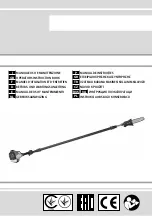
3. Remove the blade and replace with a new blade with the
appropriate shank profile. Ensure the blade has the
correct tooth per inch count for the desired application.
4. Tighten the screw, making sure that the locating pin
remains in the hole provided for it in the blade.
5. Always check to see if the blade is secure after the cap
screw is tight. Grasp the back side of the blade (side
with no teeth) and gently try to wiggle it. If the blade is
loose, remove the screw and reposition the blade.
Inserting the Battery Into the Saw
1. Ensure the trigger lock is in the locked position.
2. Insert the battery into the handle of the saw so that the long end is
forward. The battery will only fit in one direction.
3. Make sure that the battery snaps into place securely.
Choosing the right blade
The harder and thinner the material to be cut, the more teeth per inch is
required. Use accessories properly. Use the right blade for the job. Be aware
of the blade TPI necessary for the type and thickness of the material being
cut.
TPI
Material
24
Sheet metal/stainless steel
14
Metal/wood/nails
14/10
Soft metals/wood
10
Wood
6
Rough cut wood
Choosing the Blade Speed
Blade speed is controlled by the trigger. The further the trigger is depressed,
the faster the saw reciprocates. This allows for a speed range of 0 to 2,800
RPM. Using the right blade and blade speed will allow faster cutting
operation, longer blade life and will prolong the life of the saw. Generally,
the harder and/or thicker the material, the slower the speed should be. Use
the appropriate blade speed. This will require some practice on the part of
the operator. If the blade seems to dull quickly, replace and use a slower
blade speed. If cutting wood, many woods can be cut at faster speeds.

























